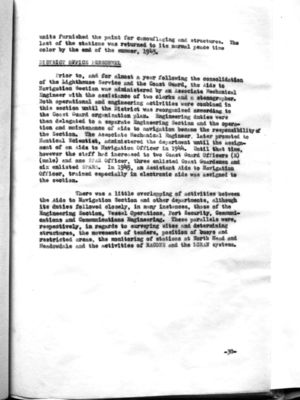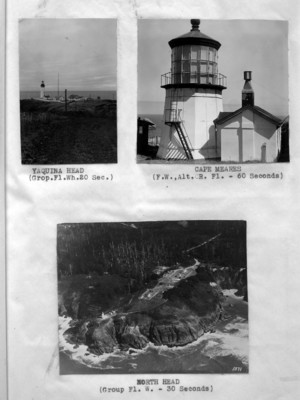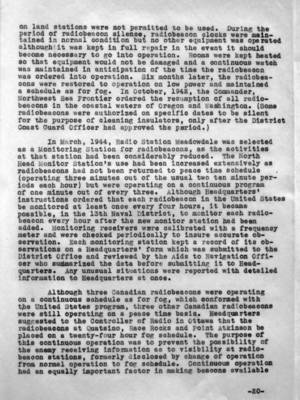Pages That Mention North Head
Coast Guard District narrative histories 1945
13
units furnished the paint for camouflaging and structures. The last of the stations was returned to its normal peace time color by the end of the summer, 1945.
DISTRICT OFFICE PERSONNEL
Prior to, and for almost a year following the consolidation of the Lighthouse Service and the Coast Guard, the Aids to Navigation Section was administered by an Associate Mechanical Engineer with the assistance of two clerks and a stenographer. Both operational and engineering activities were combined in this section until the District was reorganized according to the Coast Guard organization plan. Engineering duties were then delegated to a separate Engineering Section and the operation and maintenance of aids to navigation became the responsibility of the Section. The Associate Mechanical Engineer, later promoted to Nautical Scientist, administered the department until the assignment of an Aids to Navigation Officer in 1944. Until that time, however the staff had increased to two Coast Guard Officers (R) (male) and one SPAR Officer, three enlisted Coast Guardsmen and six enlisted SPARS. In 1945, an Assistant Aids to Navigation Officer, trained especially in electronic aids was assigned to the section.
There was a little overlapping of activities between the Aids to Navigation Section and other departments, although its duties followed closely, in many instances, those of the Engineering Section, Vessel Operations, Port Security, Communications and Communications Engineering. These parallels were, respectively, in regards to surveying sites and deteraining??? structures, the movements of tenders, position of buoys and restricted areas, the monitoring of stations at North Head and Meadowdale and the activities of RACONS and the LORAN systems.
-30-
27
(Image top left)
YAQUINA HEAD (Grop.Fl.Wh.20 Sec.)
(Image top right)
CAPE MEARES (F.W.,Alt. R. Fl. - 60 Seconds)
(Image bottom)
NORTH HEAD (Group Fl. W. - 30 Seconds)
39
on land stations were not permitted to be used. During the period of radiobeacon silence, radiobeacon clocks were maintained in normal condition but no other equipment was operated although it was kept in in full repair in the event it should become necessary to go into operation. Rooms were kept heated so that equipment would not be damaged and a continuous watch was maintained in anticipation of the time the radiobeacon was ordered into operation. Six months later, the radiobeacons were restored to operation on low power and maintained a schedule as for fog. In October, 1942, the Commander, Northwest Sea Frontier ordered the resumption of all radiobeacons in the coastal waters of Oregon and Washington. (Some radiobeacons were authorized on specific dates to be silent for the purpose of cleaning insulators, only after the District Coast Guard Officer had approved the period.)
In March, 1944, Radio Station Meadowdale was selected as a Monitoring Station for radiobeacons, as the activities at that station had been considerably reduced. The North Head Monitor Station's use had been increased extensively as radiobeacons had not been returned to peace time schedule (operating three minutes out of the usual two ten minute periods each hour) but were operating on a continuous program of one minute out of every three. Although Headquarters' instructions ordered that each radiobeacon in the United States be monitored at least once every four hours, it became possible, in the 13th Navel District, to monitor each radiobeacon every hour after the new monitor station had been added. Monitoring receivers were calibrated with a frequency meter and were checked periodically to insure accurate observation. Each monitoring station kept a record of its observations on a Headquarters' form which was submitted to the District Office and reviewed by the Aids to Navigation Officer who summarized the data before submitting it to Headquarters. Any unusual situations were reproted with detailed information to Headquarters at once.
Although three Canadian radiobeacons were operating on a continuous schedule as for fog, which conformed with the United States program, three other Canadian radiobeacons were still operating on a peace time basis. Headquarters suggested to the Controller of Radio in Ottawa that the radiobeacons at Quatsino, Race Rocks and Point Atkinson be placed on a twenty-four hour fog schedule. the purpose of this continuous operation was to prevent the possibility of the enemy receiving information as to visibility at radiobeacon stations, formerly disclosed by change of operation from normal operation to fog schedule. Continuous operation had an equally important factor in making beacons available
-20-


